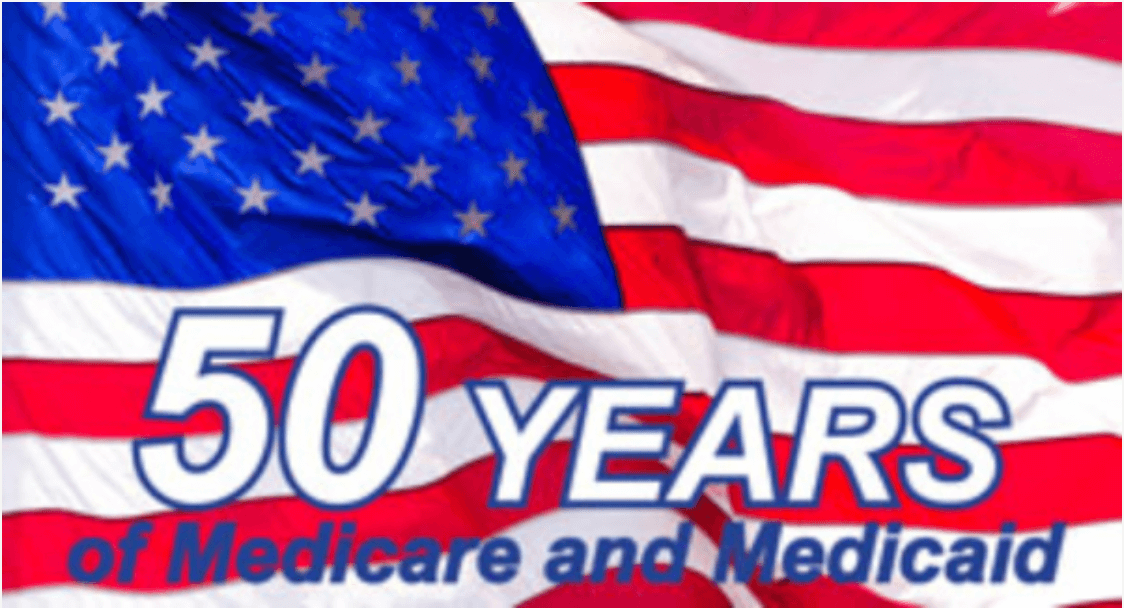August 5, 2015

Medicare at Fifty: More Yesterdays than Tomorrows?
Market Corner Commentary: August 5, 2015-Medicare at Fifty: More Yesterdays than Tomorrows?
A version of this commentary appeared in Huron Healthcare’s “Perspectives” on July 30th
With Harry Truman watching, Lyndon Johnson brought Medicare and Medicaid to life on July 30, 1965.
Recognizing Truman’s advocacy for national healthcare, LBJ staged the signing ceremony in Truman’s hometown of Independence, Missouri.
Leaning over Truman (as only he could do), LBJ proclaimed, “We want the entire world to know that we haven’t forgotten who is the Real Daddy of Medicare.”
So began America’s experiment with national health insurance. Under Medicare, health coverage for America’s seniors has grown from under fifty percent to ninety-six percent. It also provides health insurance to people with permanent disabilities.
Moreover, Medicare was instrumental in integrating the nation’s still-segregated healthcare delivery system. Overall, the program covers fifty-four million Americans, a fifth of the country’s population. Medicare is fundamental to America’s social “safety net”.
While Medicare has made incremental adjustments to expand coverage and control costs, the program largely operates as originally designed with centralized payment, monitoring and enforcement.[1]
Success, but…
Despite its successes, Medicare’s original sins (activity-based payment and no federal interference in medical decision-making) have created an overbuilt, high-cost, acute-centric delivery system. It incentivizes overtreatment, invites manipulation and underfunds vital care services, including behavioral health and chronic disease management.
Commercial insurers have replicated Medicare’s payment methodologies and treatment codes, which compounds the overall health system’s high cost and inefficiency.
Medicare Payment Formulary
Noted Princeton economist Uwe Reinhardt uses the following chart to detail Medicare’s methodology for computing inpatient reimbursement payments[2]:
As illustrated above, Medicare’s payment is remarkably complex. It’s also easy to “game”. Doctors and hospitals can maximize payment by selecting the most lucrative billing codes and delivering all “justifiable” treatments. At the margins, Medicare’s payment system rewards overtreatment and invites manipulation, even fraud.
To police illicit billing activity, the system incorporates a heavy and expensive regulatory and compliance burden for both Medicare and providers.
It’s notable that Medicare’s algorithm omits payment for superior outcomes and penalties for inferior outcomes.
To its credit, Medicare has begun incorporating some value-based criteria and readmission penalties into reimbursement payments. While directionally right, these performance incentives have been insufficient to fundamentally shift provider behavior toward outcomes-based delivery.
Medicare’s Productivity Paradox
The U.S. government employs centralized planning to design, administer and police Medicare. Each March, Medicare’s Payment Advisory Commission (MedPac) presents a mind-numbing report to Congress on Medicare payment policy.
The 2015 report[3] exceeds four hundred pages and reads like the central planning document it is. With few exceptions, Medicare reimburses providers for specific treatments. Since its enabling legislation prohibits federal interference in medicine provision, Medicare must reimburse providers for all “reasonable” services.
Consequently, hospitals and doctors have economic incentives to provide as much justifiable care as possible. As currently administered, Medicare cannot control the amount of care it reimburses.
This combination of centralized management, limited budget control and perverse incentives (“more care is better”) creates a productivity paradox where providers exploit complex payment mechanics for their own benefit at society’s expense.
The result is a bloated healthcare system consuming an ever-larger share of the U.S. economy. Estimates of the “waste” in U.S. healthcare (including Medicare) exceed $1 trillion[4] and represent roughly a third of total U.S. healthcare spending.
Private Market Innovation
Consumers, employers and the marketplace are fighting back by requiring better value, more transparency and greater convenience in healthcare delivery.
Historically, Medicare has been the principal innovator in payment and delivery reform. Current healthcare reform’s most promising feature is the extent to which private-sector innovation has leap-frogged governmental innovation (see chart below).
Private market innovators anticipate greater customer engagement in healthcare decision-making. They believe companies delivering higher-value care will differentiate from competitors and win market share.
Medicare Joining the “Value” Party
Earlier this year, HHS Secretary Sylvia Matthews Burwell announced Medicare’s intention to dramatically increase “risk-based payments” to providers – from under ten percent currently to fifty and eighty percent by 2016 and 2018 respectively.
Last month, Secretary Burwell announced Medicare would pursue bundled payments for joint replacements in seventy-five markets nationwide. Expect even more expansive bundled payments for high-volume procedures. Medicare uses this arrow graphic to identify its various risk-based payment strategies.[5]
Spurred by societal demands for better, more affordable and more convenient care services, the private market is propelling U.S. healthcare, including Medicare, toward value-based delivery.
Traditional Medicare is disappearing. Expanding Medicare Advantage enrollment, aggressive use of bundled payments and more value-based purchasing link Medicare payment to efficient resource allocation and better outcomes.
What Should Providers Do?
Value-based payment rewards health companies that deliver better, more appropriate and convenient care at lower costs. This type of market mindset is foreign to most health system managers. For decades, they have relied upon a regulatory mindset that pursues revenue optimization. Cost, outcomes and customer satisfaction have been secondary considerations.
Given this operating reality, increasing healthcare consumerism and market pressures to deliver “value”, how should providers respond? Here are a few suggestions:
- Don’t Dig a Deeper Hole: Refrain from new investments and strategies predicated solely on receiving higher payment rates. If a new initiative doesn’t intrinsically provide better care at lower costs, don’t pursue it.
- Decant Routine Care to Lower-Cost Facilities: Don’t expect continuation of higher payments for routine procedures performed in high-cost settings. Respond to payor and consumer demands for more cost-effective and convenient routine care in lower-cost, distributed ambulatory facilities. Where possible, extend hours to increase access and reduce per-unit costs.
- Standardize, Reduce Variance and Improve Quality: Become a true “clinical outcomes” organization. Practice care that generates the best outcomes. Quality improvement and cost reduction will follow. Publishing care outcomes increases accountability and accelerates improvement. Dr. Rick Afable, the CEO for St. Joseph Hoag Health, asks this provocative question, “Which of our patients signed-up for the higher variation, lower quality care?”
- Understand Costs: Deep-six cost accounting systems tied to revenues (i.e. ratio of costs to charges). Move toward time and activity-based systems that align per-unit costs and revenues in meaningful ways.
- Speak and Live the Truth: most health systems say they put patients first, but often sublimate patient needs to physician demands, reimbursement realities and organizational inertia. Consumerism is coming to healthcare. Providers that square their operations with their rhetoric win customer trust and competitive advantage.
Healthcare’s “Real Daddy”
At Medicare’s inception, prominent UCLA professor Milton Roemer saw the future. He observed, “Supply may induce its own demand in the presence of third-party payment.”[6] In other words, doctors and hospitals would create their own demand for treatments.
Fifty years later, the U.S. can no longer toleratesupply-driven demand for healthcare services. It’s too expensive, too inefficient and too error-prone.
As President Bill Clinton turned fifty in 1996, he wryly observed that he had “more yesterdays than tomorrows.” The same is true for Medicare. Wish traditional Medicare happy birthday. Also get ready to kiss it goodbye.
Demanding consumers, service-oriented providers and user-friendly information/interface companies have enough market power to normalize healthcare’s distorted supply-demand relationships.
Who is healthcare’s “Real Daddy” now? It’s the market (not the government)!





